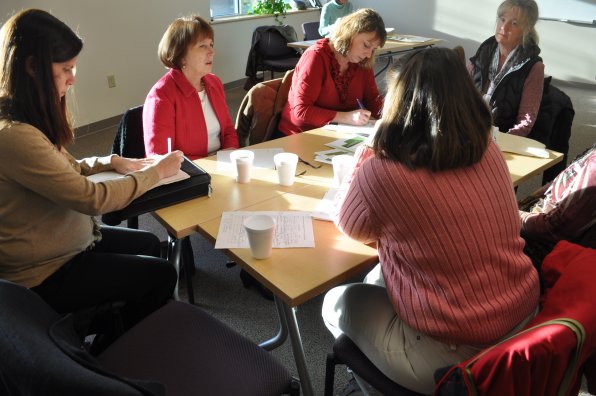We all make difficult choices on a daily basis: Do I make someone else assemble, cook and drive a pizza to my front door by ordering it from my smartphone or my tablet? Do I get together with my friends in a Google+ hangout or on Skype? Do I walk all the way to the end of the driveway to get the mail or should I just have my iServant do it?
Apple admittedly hasn’t developed the latter device yet (as far as you know), but here is a growing trend in the decisions we make – we’ve taken the activity out of our activities. Modern conveniences may represent impressive feats of engineering, but they are also threatening to represent impressive feats in not using our feet.
Alas, all hope is not lost. The Capital Area Wellness Coalition is watching, and it wants you to skip the elevator and take the stairs.
Formed in the fall of 2009, the coalition is a group of health-minded inpiduals from all sectors of wellness focused on helping people and businesses make better choices, be it in the foods they consume or the opportunities available for healthy activity. According to the group’s website, its mission is about “connecting people to healthy opportunities.”
“It’s trying to connect people and organizations that are interested in wellness; wellness defined as either eating healthier, being more active or lowering your daily stress levels,” Shawn LaFrance, coalition member and executive director of the Foundation for Healthy Communities in Concord, said. “There are a lot of people that are concerned about this and trying to do things to make everything or every place healthier, and the coalition is the place to kind of knit those efforts together.”
It is indeed a melting pot of movement, as inpidual members bring raw ideas to the table and the group massages them into concrete plans. The coalition meets once a month at the Smile Building and brainstorms ways to help people implement those healthier strategies, in schools, businesses or on an inpidual level. The members are all volunteers and come from a variety of backgrounds – including the chamber of commerce, the school district, Concord Hospital and other organizations – and are united in a quest to return the vigor to the general population.
“The primary motivating factor is persona passion. I think that’s how the coalition works; it steers itself in a very organic way,” Margaret Fletcher said. “It’s stayed alive because of a dedicated group of people who care about wellness at the infrastructure, public policy, healthcare and food supply levels.”
The coalition was formed when a handful of local wellness advocates noticed similar groups popping up in other communities, and it didn’t take long to get things off the ground in Concord. The first major event was a summit at Red River Theatres and the Capitol Center for the Arts that took more than a year to put together, and the group’s work has certainly been noticed, as evidenced by an appearance from Michelle Obama during a Let’s Move event hosted by the first lady on March 9, 2012.
“One of the things that comes out of it is we brought all these wellness coordinators together from different agencies, and we just sort of network and maximize each other,” Johane Telgener, director of the Concord Hospital Center for Health Promotion, said. “And now it’s how can we sort of tag onto some other things happening in Concord, like with the Complete Streets initiative, how can we give support through our Prefer to Walk campaign? It’s fun to watch how it’s all intertwined and we really do need each other.”
The coalition is working on a pilot project with a handful of local businesses encouraging employees to take the stairs instead of the elevator. A device that counts the number of people who use the stairs will take statistics for a month before the reminders and encouragement begin. The reminders will take place for three months, after which the coalition plans to count the number of users over the course of a month again to see if the stairwells have gained any increased traffic.
Modern architecture represents an impediment, though the coalition is determined to overcome it.
“In newer buildings, just because of the way they’re designed, the elevators are always very prominent and often times it’s a challenge to find the stairwell,” LaFrance said. “But if you think about older buildings, like the historical society’s Tuck Library building downtown, there’s a wonderful grand staircase when you walk in the door, and the elevators are tucked behind it in the back.”
If the project proves successful, the coalition would love to do the same with other local businesses and organizations, LaFrance said.
Other ideas that were kicked around at the Dec. 12 meeting included the potential to add EBT-access at farmers markets, a discussion about encouraging more young children to get involved in run/walk events and the possible addition of water fountains at local schools designed to refill bottles in order to prevent students from constantly opening new ones, thereby reducing plastic waste.
The coalition receives no funding, operating instead on grants and in-kind donations. As Fletcher said, “It’s all good-hearted volunteerism.”
Similarly, there is little hierarchy of members. Anyone is encouraged to attend meetings and get involved as much or as little as desired, and as long as plans for wellness in action are being discussed, the group is achieving its goal.
“I picture that all of these people back at their desks have a little corner of their heart where they’re passionate about (wellness), and suddenly you have this roof you can show up under and it’s through that connection that something different happens. You get just three people around the table and you can see the illustration of that passion. Our mission is fulfilled the minute anyone walks in that door,” Fletcher said. “Getting together with people who are about wellness is wellness-inducing. It’s infectious.”









